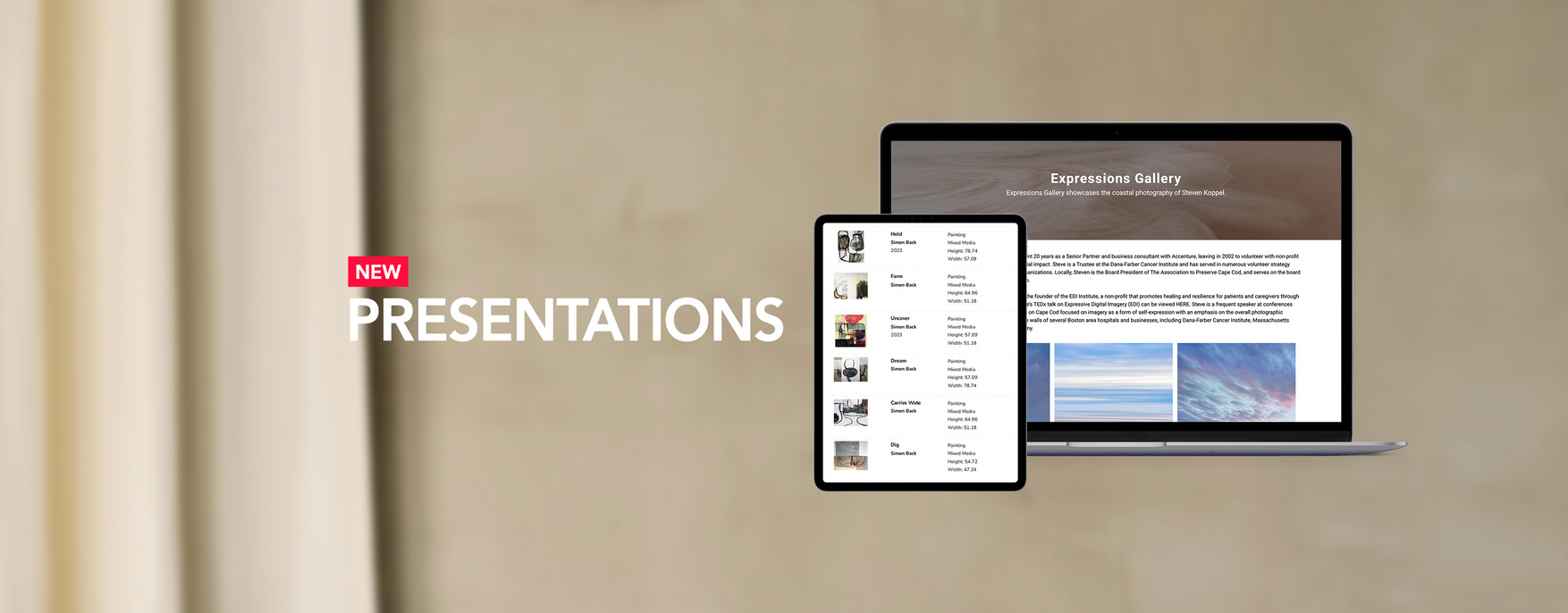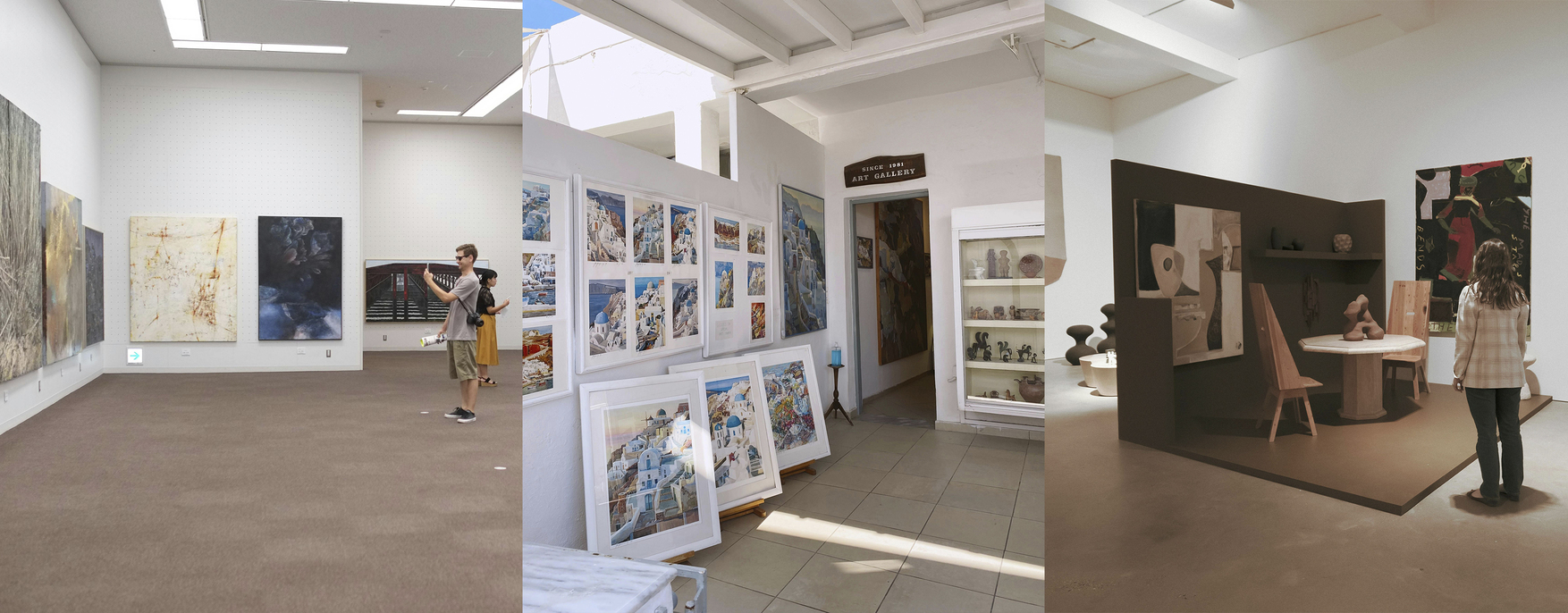Selling art has become a hybrid experience, blending in-person interactions with powerful art marketing tools. Whether you’re a gallerist or an artist, there are innovative ways to showcase art, connect with potential clients, and spark meaningful conversations that lead to sales.
In this blog, you’ll discover insider tips and recommendations on how to present your art effectively to boost sales.
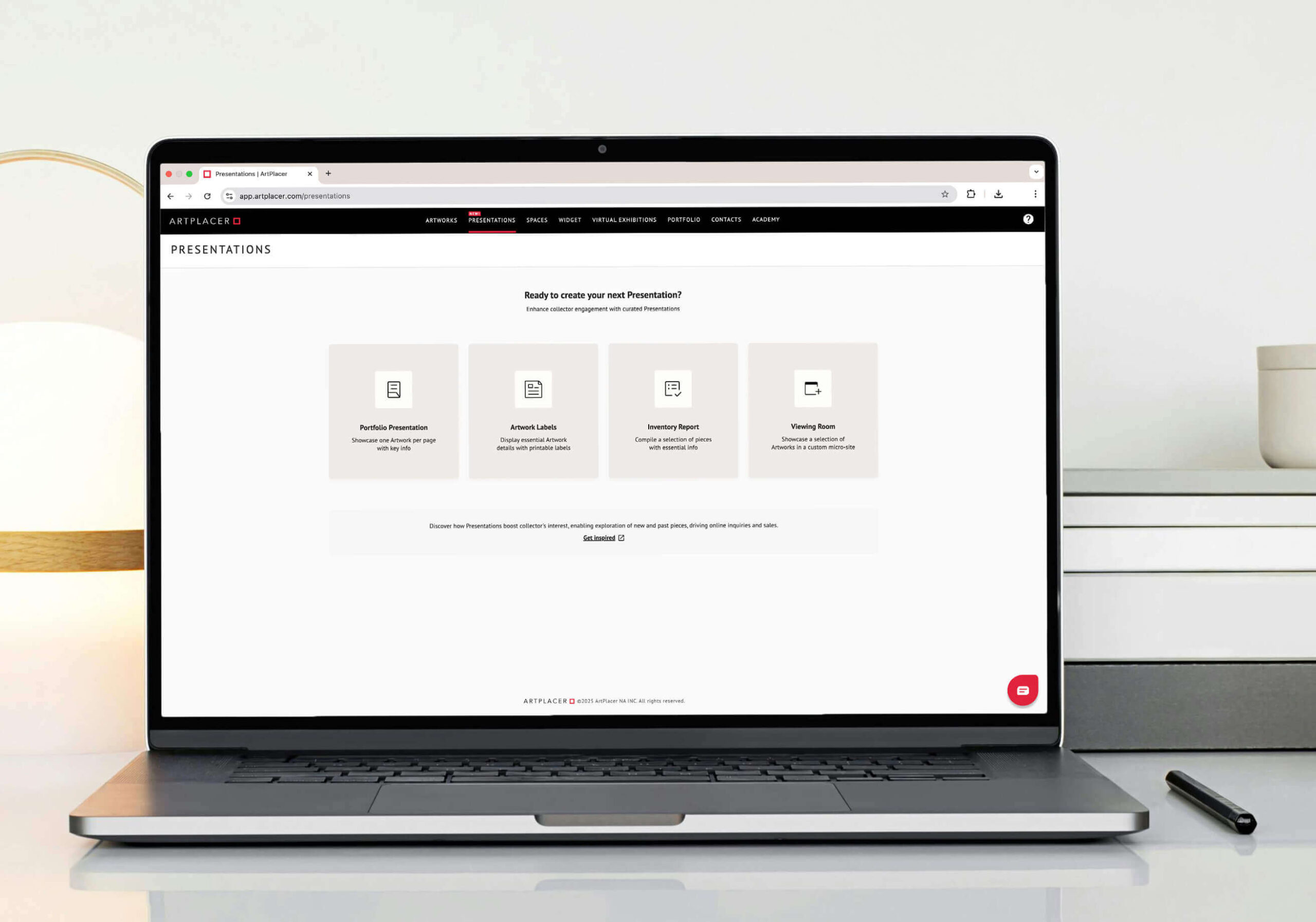
Meet ArtPlacer’s new Presentations features to help you manage and showcase your artwork to push for sales.
Contents
Sparking art sales-driven conversations with potential collectors
Engaging with potential collectors is one of the most critical tasks for gallerists, art dealers, art business managers, and artists. It’s not just about starting conversations, it’s about building meaningful connections by providing collectors with the information they need to make confident and satisfying purchases, like learning more about the artist and the piece they are acquiring and the value of the new piece they are adding for their collection.
But how can you effectively pitch and communicate all the essential details about an artwork in just a few minutes or even through a single email exchange?
Fortunately, there are tools available to help you captivate collectors with visually striking presentations and personalized collections tailored to their interests and needs. For example, ArtPlacer’s new Presentations feature enables you to create engaging Portfolio Presentations in the form of stunning PDF showcases. These resources showcase a curated selection of artworks along with key details, making it easier than ever to inspire confidence in the collector’s purchasing decisions.
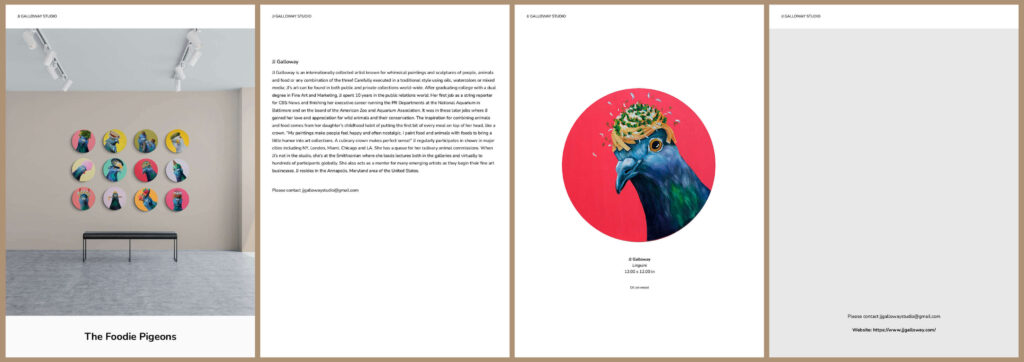
Example of a Portfolio Presentation created with ArtPlacer.
For gallerists and art dealers, being able to showcase bespoke collections is a powerful way to captivate clients and meet their unique preferences. Tailored collections not only enhance the art-buying experience but also encourage buyers to take the next step in their journey and this visual asset shows their needs are at the center of this interaction.
With ArtPlacer’s Portfolio Presentation, you can effortlessly curate and present a selection of artworks grouped by theme, subject, or artist. This feature is a great asset to follow up on a conversation you had with a visitor to your gallery or art fair booth that has shown interest in a particular piece. With this exquisite portfolio, you can showcase available artworks with a strong visual storytelling around the artist and their body of work, highlighting the value of the piece and possible investment a collector would make.
Visual storytelling assets hold significant power for a gallery. As gallerist Steven Koppel explains: “Storytelling is extremely important to everything we do at the gallery. My customers love hearing the story behind my images—where they were created, why they are meaningful to me, the techniques I used in the field with my camera, and why I chose them for display in the gallery. This storytelling creates a relationship with my customers that is fundamental to everything we do.”
Artists and photographers can also benefit greatly from this tool. By creating themed Portfolio Presentations enriched with detailed artwork information, they can effectively engage collectors and spark meaningful connections. This is the perfect asset to showcase your body of work when applying for grants, residencies, or calls for artists or even when seeking gallery representation. It offers an elegant, concise summary of your portfolio, presenting all the essential details reviewers need to know in a clear and engaging format.
A PDF portfolio showcasing their artist statement alongside key artwork details is an invaluable resource. This versatile asset not only helps artists present their work professionally but also supports their career growth. It can be used to apply for grants, residencies, and even gallery representation, making it a must-have for any creative professional.
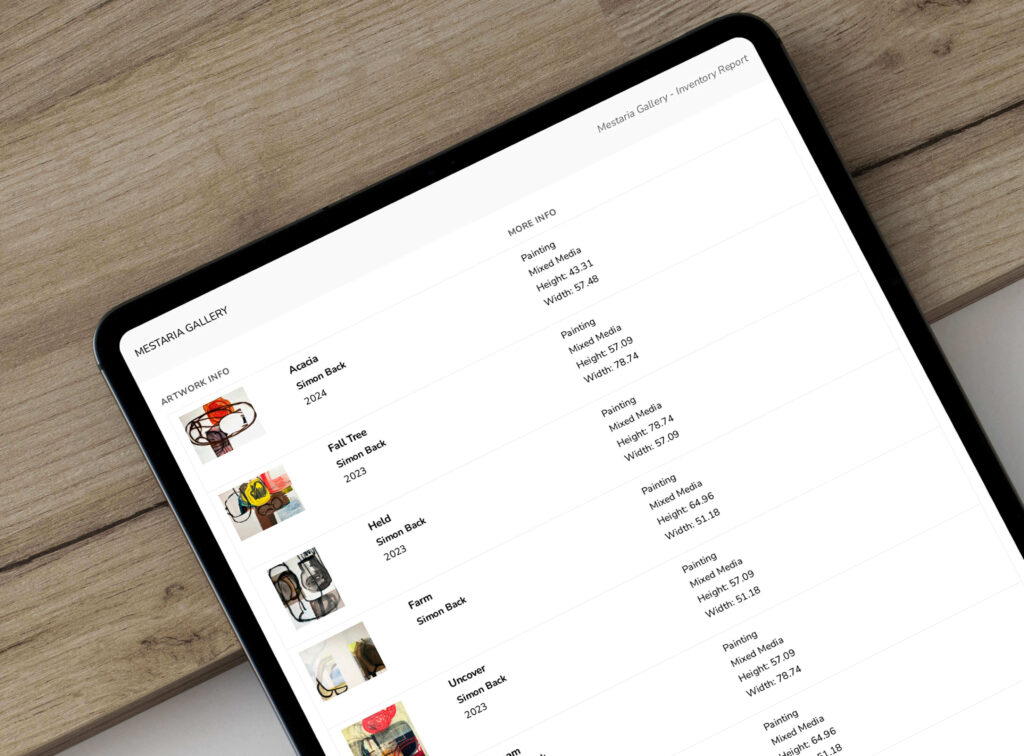
Take a look at ArtPlacer’s Inventory Report and how to stay on top of your stock.
How to manage your artworks with ease and focus on sales
Behind every successful art showcase lies a critical task that everyone, from seasoned gallerists to emerging artists, must master: artwork management and organization. Maintaining an accurate record of your current and past pieces is essential for managing your business at any level. This clarity allows you to know exactly what you have on hand, helping you identify pieces to promote and confidently navigate sales-driven conversations.
With ArtPlacer’s Inventory Report, you can now effortlessly create a polished, easy-to-visualized PDF catalog featuring a detailed list of your artworks. This digital tool streamlines catalog management, helping you stay organized and focused on what matters most: connecting with your audience and driving sales. With all your artwork information uploaded to ArtPlacer, creating an Inventory Report is just a matter of a few clicks, this simple process saves you time and resources in what once was a consuming task.
Galleries and art dealers can use Inventory Reports to stay organized and create bespoke lists of available artworks tailored to a client’s specific needs or requirements for a potential sale with essential information like artwork title, artist name, year, medium, material, dimensions, price and description. This personalized approach enhances the client experience and increases the likelihood of closing the deal.
Pro Tip: Pair the Inventory Report tool with the Art Show Planner for physical exhibitions like art fairs to have a clear overview of your available catalogue. This combination allows gallerists to easily track artworks brought to the event, review current stock, and complement the show planner’s information while on-site. Together, these tools ensure seamless organization.
Art print businesses can greatly benefit from Inventory Reports, a tool designed to streamline operations and enhance professionalism. It helps keep track of artwork availability and gives you an overview of stock for sales of existing art prints.
Just like art print businesses, artists of all kinds can use this tool to stay organized. It also offers a tailored way to showcase their work, whether responding to a client’s specific request, presenting their portfolio for gallery representation, or applying to calls for artists.
Inventory Reports turn what was once a complex task into a streamlined process, freeing up your time to concentrate on building meaningful relationships with clients and advancing other important aspects of your work. You can easily produce this document with a few clicks based on the artwork information you have already uploaded to ArtPlacer.
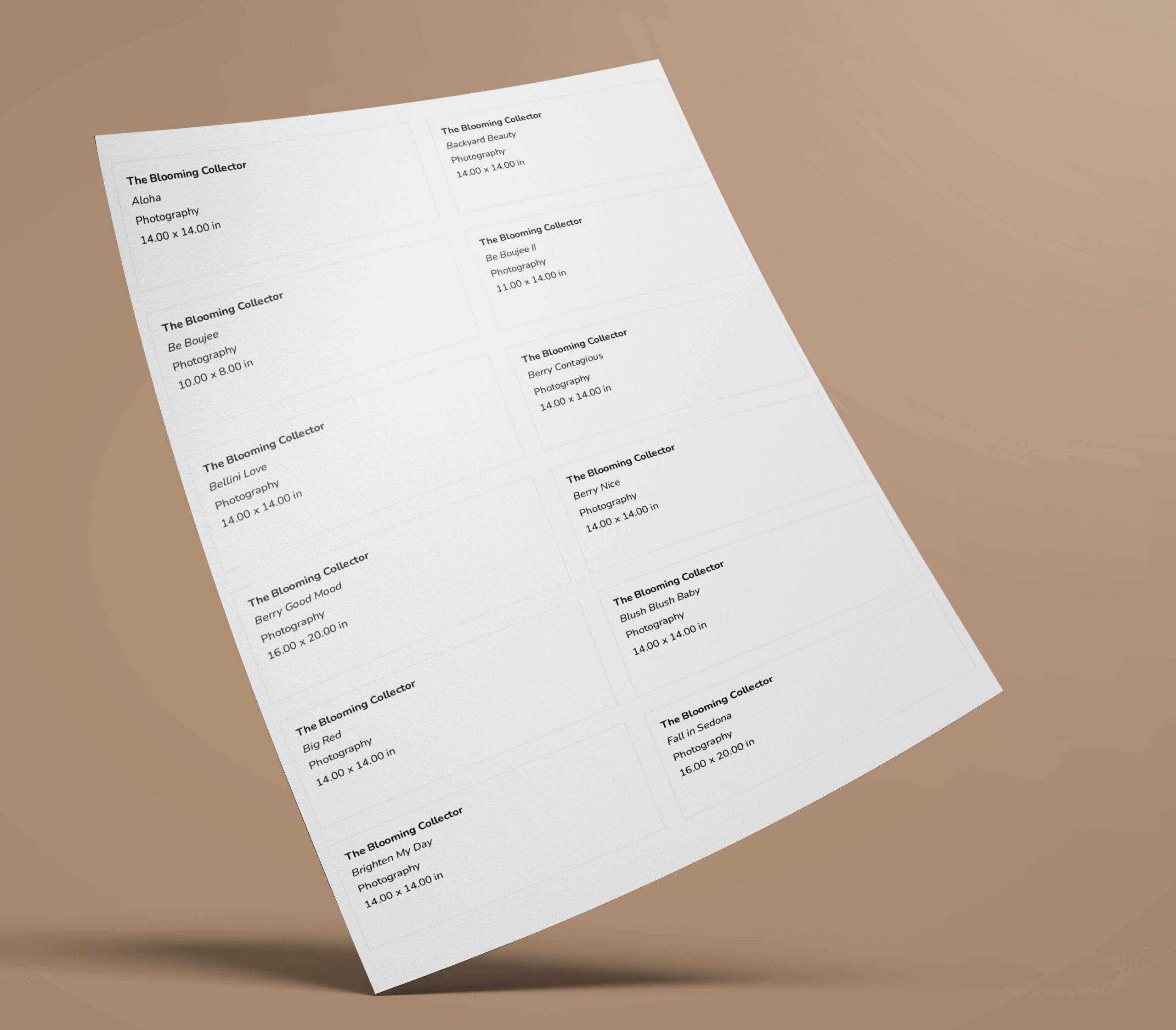
See an example of Artwork Labels ready to print and place on an art fair or gallery wall.
An added benefit of keeping your artwork stock organized is the ease with which you can prepare for exhibitions. What once was a time-consuming task that involved design and data collecting, can now be ready in just a few clicks: with all your artwork information updated in ArtPlacer, you can seamlessly create printable labels or Artwork Labels that identify each piece. This allows you to engage visitors effectively by providing essential details on-site during physical exhibitions and art fairs like artist name, artwork title, medium, size, and price.
Taking your in-situ art show into the digital realm isn’t just about replicating what exists in your physical gallery, it’s about crafting a hybrid experience. Think of it as an extension of your curatorial process, allowing you to experiment with dynamic formats like videos and GIFs, opening up new avenues for dialogue with your artworks and the story you want to tell.
Ready to explore how the physical and digital worlds can intertwine? Dive into our blog, “Worlds Intertwine: How to Bring Your In-Situ Exhibition Online“, and discover how to elevate your exhibitions.
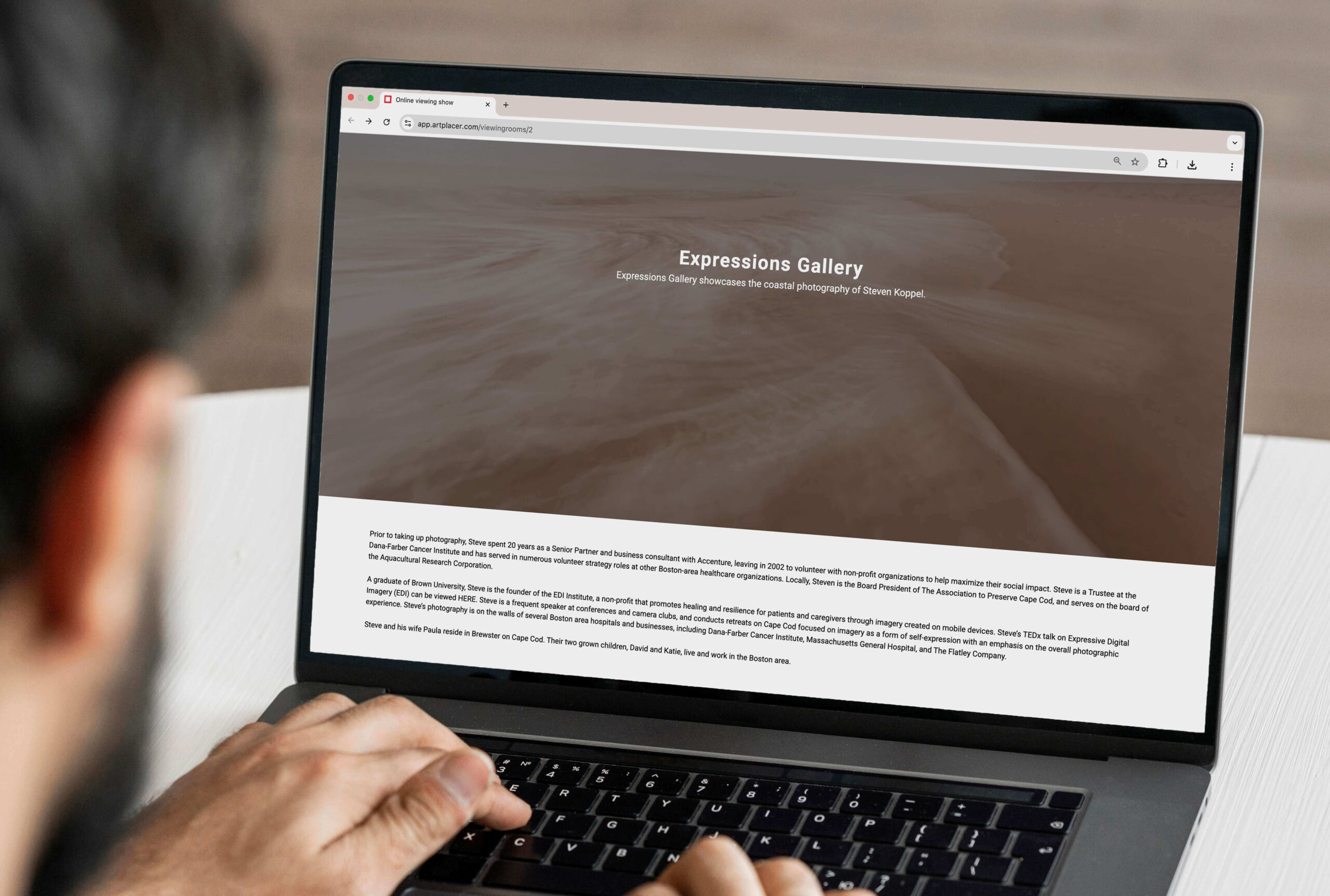
Online Viewing Room as seen on a tablet, a perfect asset to carry with you during exhibitions or art fairs.
Creating showcases of artworks that convert potential clients into art buyers
Think about where you showcase art as a blend of physical spaces like galleries, art fairs, and exhibitions, and the digital realm, including social media, your website, and 3D virtual exhibitions. These two experiences shouldn’t exist in isolation. Instead, they become far more impactful when combined to provide visitors and potential buyers with an immersive, memorable experience.
ArtPlacer Online Viewing Rooms offer an immersive, custom micro-site experience designed to showcase a curated selection of artworks and easily share them with your desired audience with four exclusive, ease-to-customize template designs. As you can see, this tool seamlessly bridges the physical and virtual worlds. See an example Online Viewing Room from Expressions Gallery here.
Online Viewing Rooms make it easy to recreate an in-situ show while also generating a QR code linked to the exhibition. By adding this QR code to your physical gallery or art fair booth walls, you can offer visitors access to additional information about the art and artist, enhancing the storytelling and deepening their connection to the show.
Gallerists can showcase this digital version of the physical show on an iPad or any mobile device making it easy to present the available pieces. If the visitor requests further information about an artist, these Online Viewing Rooms can be easily paired with Portfolio Presentations created per each showcased artist.
These assets serve as valuable tools to drive sales conversations, helping potential collectors progress through the Art Buyer’s Journey, a process that begins with discovering your artwork and culminates in a purchase. Rooted in the power of visual storytelling, they play a pivotal role in engaging collectors and guiding them toward their final decision.
It is in examples like this where we can see how this tool, instantly sparks sales-driven conversations, whether you’re showcasing art in a gallery exhibition or at an art fair, plus, it gives the potential client a link they can take home to further interact with the pieces and learn more about the art they are thinking about acquiring with the added ability to visualize it on their walls with the help of Augmented Reality technology.
You can also promote exhibitions in advance by creating a preview of the show and sharing it with top collectors through an exclusive email marketing campaign or turn it into a lead magnet bringing an audience of new interested visitors with a data capture form.
The power of exclusivity and customization lies at the heart of Online Viewing Rooms. To impress potential collectors, art dealers to artists can create a bespoke site that delivers an exclusive experience tailored to their preferences. For instance, you could craft a collection of artworks specifically aligned with their needs and interests, such as a personalized selection of abstract pieces. Imagine receiving a 100% exclusive, custom-tailored approach that not only elevates the collector’s experience but also strengthens sales-driven conversations.
If you’re an art dealer looking to present a selection of artworks for placement in housing, design, or commercial spaces, collaborating with architects and interior designers, you can create an Online Viewing Room with a curated collection of suggested pieces. This unique, immersive experience will effectively showcase your proposal and bring your vision to life for residential or commercial projects.
Today, selling art is all about offering bespoke experiences that allow clients to interact with the pieces, access detailed information, and engage through visual storytelling. This approach helps them make informed decisions, leading to satisfying purchases while fostering relationships that nurture and grow your art business. Are you ready to integrate these new experiences into your daily routine and take your art sales to the next level?
Log in to your ArtPlacer account or start your free trial and start creating your Presentations.
